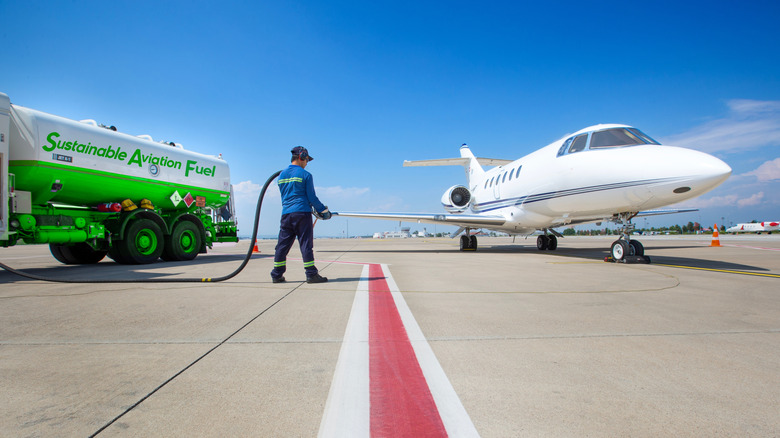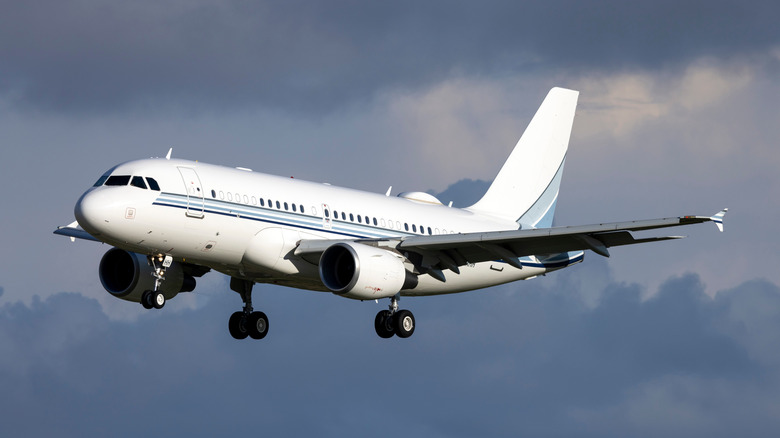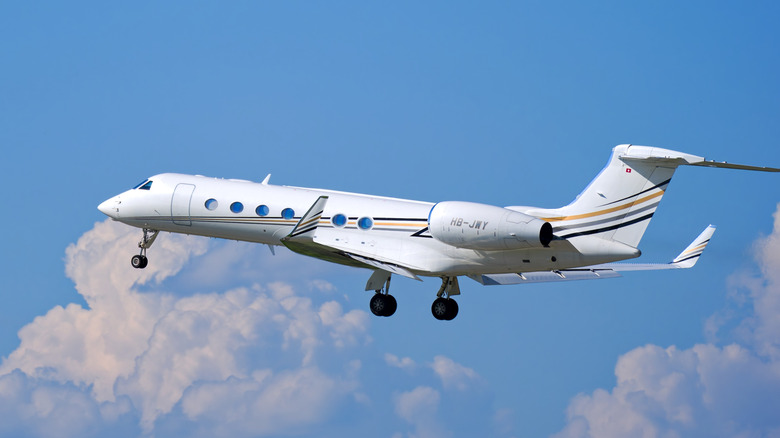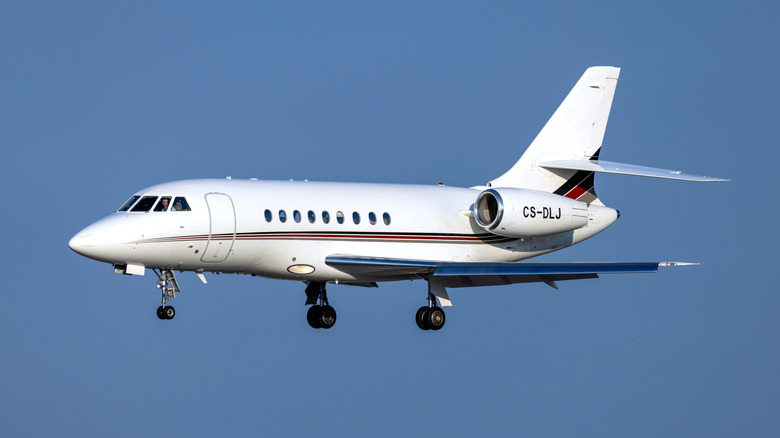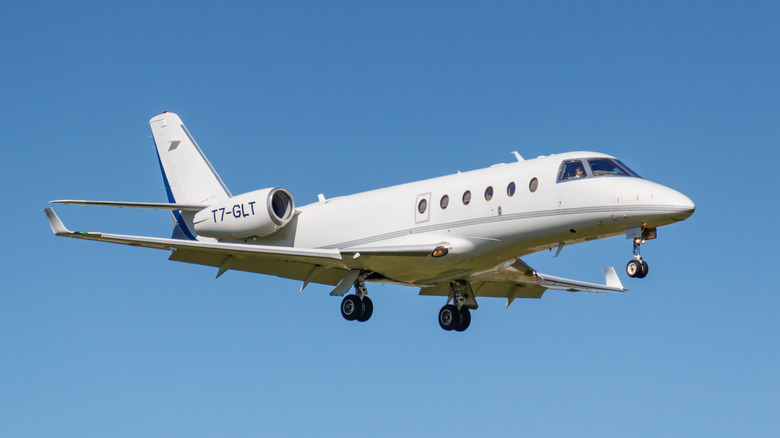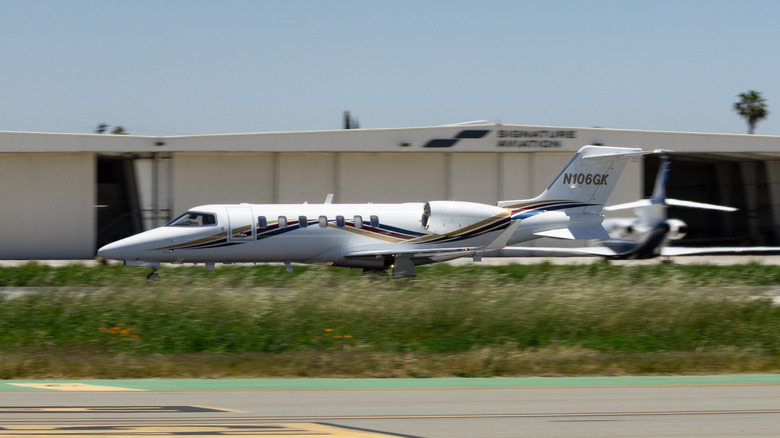5 Of The Most Fuel Efficient Private Jets In The Air Today
People prefer private jets over commercial airlines because not only do they provide a secluded space, but they also fly faster than commercial planes. Private jets can't just land anywhere, but they have dedicated airports, so security, immigration, and most importantly, privacy aren't much of a problem, unlike at commercial airports. Private jets come in all shapes and sizes, and their cost is sky-high. As the world moves towards reducing its carbon footprint, fuel efficiency has become a top priority for the aviation industry. Private jet companies are also shifting towards eco-friendly private jets, not only to reduce environmental impact but also to attract eco-conscious clientele.
Private jets traditionally burn large amounts of fuel — so much so that a 2-hour flight can generate more CO2 emissions than an average person produces in a year. Not only does opting for an eco-friendly private jet help achieve longer range, but it also often lowers the overall cost of private jet ownership. There are a lot of factors, such as the aircraft design, engine performance, weight, and others, that impact fuel efficiency.
In this guide, we have highlighted five of the most fuel-efficient private jets in each major category – VIP airliner, ultra long-range jet, large cabin jet, super midsize, and midsize jet – according to data by Private Jet Card Comparisons.
VIP Airliner -- Airbus ACJ319 Neo (603 GPH)
The Airbus ACJ319 Neo is not only the most fuel-efficient VIP airliner, but also among the most expensive luxury aircraft today. It is an Airbus A319CJ upgraded with improved comfort, technology, speed, and range. This aircraft not only offers unmatched luxury but also advanced safety, reliability, and top-of-the-line aviation technology. With an impressive range of up to 6,750 nautical miles, it is perfect for long-haul, non-stop journeys. Airbus claims that it has the quietest cabin in the sky while offering space of up to 96 square meters.
The Airbus ACJ319 Neo was first manufactured in 2019, and it continues to be in production. The extended range and low fuel consumption of 603 GPH (Gallons Per Hour) make it a wise choice for those long-haul journeys with minimum stopovers. It comes with a seating capacity of up to 19 seated passengers, with arrangements possible for 12 single and two double beds. The ACJ319 Neo can reach a maximum speed of 469 kts, which is approximately 868.6 kmph.
The ACJ319 Neo can be equipped with either 2x CFM International LEAP-1A or 2x Pratt & Whitney PW1100G, both new-generation turbofan engines focused on fuel efficiency and reduced emissions. According to Airbus, this private jet is designed to fly 15 hours a day and has a shorter takeoff distance, but with an impressive payload.
Ultra Long Range -- Gulfstream G550 (438 GPH)
Produced from 2003 to 2021, the Gulfstream G550 is the most eco-friendly and fuel-efficient ultra-long-range aircraft in its category, according to data by Private Jet Card Comparisons. It was manufactured as an upgrade to the Gulfstream V (also known as GV) and can carry 19 passengers with a maximum range of 7,700 nautical miles (14,501 km). This means that it can fly from New York to Dubai without needing a stopover for fuel in between. It is powered by two Rolls-Royce BR710 turbofan engines, producing 15,385 lbs of thrust each. With the advanced PlaneView avionics suite, featuring four Honeywell Primus Epic 14-inch flat-screen displays, information is displayed with crystal-clear quality.
The Gulfstream G550 has a fuel consumption of 438 GPH, which is one of the reasons why it is a favorite of many top pro athletes. It can attain a maximum cruising speed of 904 km/h, has a ceiling of 51,000 ft, and can take off on a runway that is at least 5,910 ft long. The Gulfstream G550 is also recognized for its technological prowess and safety features, which helped it bag the Robert J. Collier Trophy in 2003.
The aircraft has also set 50 city-pair records, including London to Tokyo in 11 hours and from Beijing to New York in 14 hours. It comes with all the luxury amenities in its raw form, which one would expect from a multi-million-dollar private jet.
Large Cabin -- Falcon 2000EX (284 GPH)
Dassault, popular for manufacturing fighter jets, is also behind one of the most popular private jets in the world, the Falcon 2000 series, which was introduced in 1995. The Falcon 2000EX is the modern version of the Falcon 2000 series plane, and it took its first flight in 2003. The Falcon 2000EX comes with an upgraded engine, new avionics, and extra fuel capacity. It is more fuel-efficient than the Falcon 2000 as well. It can carry up to 12 passengers, has a normal cruising speed of 850 km/h, and has a service ceiling of 47,000 feet.
One of the interesting facts about the Falcon 2000EX is that only 27 units were produced from 2003 to 2004 before Dassault ceased production of the Falcon 2000EX in 2009. With a maximum range of around 4,350 miles, it can fly from London to Dubai without refueling. The Dassault Falcon 2000EX consumes 284 gallons per hour, as per data provided by Private Jet Card Comparisons. It is powered by two Pratt & Whitney Canada PW308C turbofans, producing 7,000 lbs of thrust each.
Dassault introduced a new Falcon 2000EX EASy model, which was equipped with the EASy flight deck. Notably, it is the most advanced cockpit system available, featuring four large screens in a T-shaped setup that display all the important aviation metrics. It can be easily controlled using a trackball cursor control device (CCD).
Super Midsize - Gulfstream G150 (228 GPH)
The G150 is another Gulfstream that is also among the fastest super midsize aircraft. It was developed in a joint effort by Israel Aircraft Industries (IAI) and Gulfstream Aerospace. The G150 inherits the lineage of the Gulfstream G100, which offered competitive speed and range but couldn't meet the comfort levels required for a super midsize private jet. So, the company decided to increase the cabin space from 304 cubic feet in the G100 to 521 cubic feet in the G150. The Gulfstream G150 entered service in 2006, with its production stopping in 2017. It has a seating capacity of up to eight passengers, a maximum cruising speed of 870 km/h, and a ceiling of 45,000 ft.
Although the Gulfstream G150 has a typical range of 2,760 nautical miles, it set a speed record between Nice, France, and Dubai, UAE, flying 2,881 nautical miles in the process. With four passengers onboard, the G150 can fly nonstop up to 2,950 nautical miles. On top of this, it comes with the best fuel consumption of 228 GPH in its category, as per Private Jet Card Comparisons. Under the hood are the two Honeywell TFE731-40AR-200G turbofan engines, producing 4,420 lbs of thrust individually.
The Gulfstream G150 is designed to take off from shorter runways. Its interior is designed to be more comfortable and offer ample headspace, thanks to the oval-shaped cabin. The G150 comes with the Collins Pro Line 21 Avionics flight deck system, along with Gulfstream's proprietary CCD for easier control and operation.
Midsize - Bombardier Learjet 70 (198 GPH)
The Bombardier Learjet 70 stands out at the top of the midsize private jet category with a fuel consumption of 198 GPH. Bombardier launched the Learjet 70 and 75 as a replacement for the outgoing Learjet 40 and 45, which were in production for 12 and 16 years, respectively. As for the Learjet 70, it is powered by two Honeywell TFE 731-40BR-1B engines, each producing 3849 lbs of thrust. With a maximum capacity of carrying six passengers, this midsize private jet aircraft has a maximum range of over 2,000 nautical miles.
Coming to the flight system, it is equipped with a Garmin G5000 Vision flight deck that comes with a widescreen display, touchscreen controls, and a synthetic vision system (SVS) that offers 3D imagery of the external environment on the screen. To offer a personalized experience, the Learjet 70 even comes with dual-zone climate control for the cabin and cockpit.
